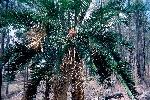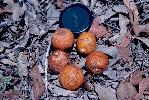Species profile—Cycas megacarpa
Classification
Plantae (plants) → Equisetopsida (land plants) → Cycadaceae → Cycas megacarpa

Go to Photo gallery
Species details
- Kingdom
- Plantae (plants)
- Class
- Equisetopsida (land plants)
- Family
- Cycadaceae
- Scientific name
- Cycas megacarpa K.D.Hill
- WildNet taxon ID
- 8445
- Nature Conservation Act 1992 (NCA) status
- Endangered
- Environment Protection and Biodiversity Conservation Act 1999 (EPBC) status
- Endangered
- Conservation significant
- Yes
- Confidential
- Yes
- Endemicity
- Native
- Pest status
- Nil
- Short Notes
- Gymnosperm, two sheets
- Description
- Cycas megacarpa is a small to medium sized cycad growing to 8m tall. It has an erect trunk, 8-14cm in diameter and a dense, rounded crown of leaves. Juvenile leaflets are blue-green, with dense orange-brown hairs that later fall off. Mature leaves are 40-110cm long, glossy, mid to dark green, and keeled (V-shaped) in cross-section. The petiole (leaf stalk) is 25-30cm long. Each leaf consists of 120-170 leathery leaflets,12-20cm long and 0.5-0.75cm wide. The lowest leaflets are reduced to spine like structures, approximately 0.5cm long.
The male and female reproductive structures develop on separate plants. Male plants produce brown, hairy cylindrical cones 15-18cm long and 5-7cm in diameter. The female plants produce loose open cone-like structures at the top of the plant. Two to four seeds are borne on female sporophylls (seed bearing structures) 15- 25cm long that have a broad flattened spear shape tip (apical lobe) with an apical spine to 2 cm long. As the seeds mature the stalks lengthen and spread away from the top of the plant. Seeds are ovoid (egg shaped), 4-6cm long by 3.5-4.5cm in diameter and greenish to light brown, not powdery.
Cycas megacarpa is distinguished from C. ophiolitica by the green new growth and larger seeds. It is distinguished from other Cycas species by the keeled green leaves and larger seeds. (Halford 1995; Hill 1998; DEWHA 2008) - Map
- View Map
- Habitat
- Cycas megacarpa occurs in spotted gum (Eucalyptus maculata) and narrow-leaved ironbark (Eucalyptus crebra) woodland and open forest with a grassy understorey. It has also been recorded on rainforest margins. The species usually grows on hill tops and steep slopes. It is found on varying top soils; commonly sandy loams or shallow clay loams which are often stony. C. megacarpa occurs at altitudes of 40-600m above sea level. (Halford 1995; DEWHA 2008)
- Behaviour
- Cycas megacarpa occurs in areas that are subjected to periodic fires of varying intensities. As with other cycads, adult plants are resistant to most fires, although the foliage may be destroyed and some scarring of the stems may occur. Fire probably kills small seedlings or seed that is either on the plant or dispersed locally. The impact of fire on foliage can be devastating, particularly when fire synchronises with new leaf emergence for the entire population. (Queensland Herbarium 2007)
- Reproduction
- Fruiting cones are produced between the months of May and February. Seeds become ripe from March onwards and drop from the tree. The seeds are not ready to germinate for at least nine months due to a delayed fertilisation technique that is unique to cycads. There is no information available on the dispersal or recruitment of this species. Male cones shed pollen and female megasporophylls are receptive in November. Pollination is effected by small beetles in an obligate mutualism. (Queensland Herbarium 2007)
- Predators
- The beetle (Lilioceris nigripes) and the lycaenid butterfly (Theclinesthes onycha) predate the foliage of C. megacarpa. (Queensland Herbarium 2007)
- Management documents
- Conservation and management of protected plants in trade in Queensland 1995-1998. Department of Environment.
Queensland Herbarium (2007). National Multi-species Recovery Plan for the cycads, Cycas megacarpa, Cycas ophiolitica, Macrozamia cranei, Macrozamia lomandroides, Macrozamia pauli-guilielmi and Macrozamia platyrhachis. Report to Department of the Environment and Water Resources, Canberra. Environmental Protection Agency, Brisbane. - Notes
- Contributors: Ailsa Holland, Paul Forster, Mellisa Mayhew 17/06/2009
- References
- Department of the Environment, Water, Heritage and the Arts (2008). Cycas megacarpa in Species Profile and Threats Database, Department of the Environment, Water, Heritage and the Arts, Canberra. Accessed 29/09/2008.
Forster, P.I. (2007). Recovery plans for endangered cycads: a model set of objectives and actions using the example of Cycas megacarpa from Queensland, Australia. Memoirs of the New York Botanic Garden 97: 3-31.
Halford, D. (1995). Cycas megacarpa, in Species Management Manual. Department of Natural Resources, Brisbane.
Herbrecs (2008). Cycas megacarpa, in BriMapper version 2.12. Queensland Herbarium. Accessed 29/09/2008.
Hill, K. (1992). A preliminary account of Cycas (Cycadaceae) in Queensland. Telopea 5(1): 177-206.
Hill, K.D. in McCarthy, P.M. (Ed) (1998). Flora of Australia 48: 604-605.
Jones, D.L. (2002). Cycads of the World, Ancient Plants in Today's Landscape. edn 2. New Holland Publishers, Australia.
Queensland Herbarium (2007). National Multi-species Recovery Plan for the cycads, Cycas megacarpa, Cycas ophiolitica, Macrozamia cranei, Macrozamia lomandroides, Macrozamia pauli-guilielmi and Macrozamia platyrhachis. Report to Department of the Environment and Water Resources, Canberra. Environmental Protection Agency, Brisbane. http://www.environment.gov.au/biodiversity/threatened/publications/pubs/cycads.pdf - Profile author
- Ailsa Holland (17/06/2009)
Other resources
- Species Profile and Threats Database (SPRAT)
- The Australasian Virtual Herbarium (AVH)
- Atlas of Living Australia
Data source
This profile data is sourced from the QLD Wildlife Data API using the Get species by ID function used under CC-By 4.0.
https://apps.des.qld.gov.au/species/?op=getspeciesbyid&taxonid=8445.
This information is sourced from the WildNet database managed by the Queensland Department of Environment and Science.






